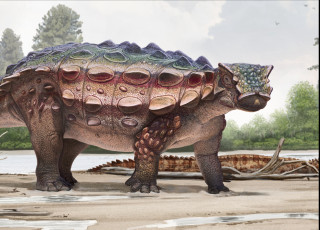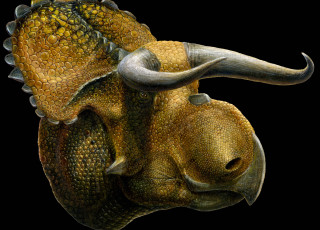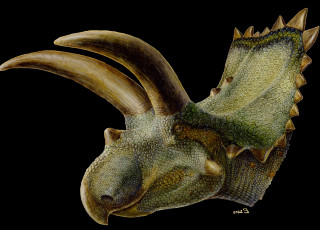New, giant horned dinosaur discovered in the ancient swamps of Montana
June 20, 2024, Salt Lake City – A remarkable, new species of horned, plant-eating dinosaur is being unveiled at the Natural History Museum of Utah. The dinosaur, excavated from the badlands of northern Montana just a few miles from the USA-Canada border, is among the largest and most ornate ever found, with two huge blade-like horns on the back of its frill. The distinctive horn pattern inspired its name, Lokiceratops rangiformis, meaning “Loki’s horned face that looks like a caribou.” The new species was announced today in the scientific journal PeerJ.
More than 78 million years ago, Lokiceratops inhabited the swamps and floodplains along the eastern shore of Laramidia. This island continent represents what is now the western part of North America created when a great seaway divided the continent around 100 million years ago. Mountain building and dramatic changes in climate and sea level have since altered the hothouse world of Laramidia where Lokiceratops and other dinosaurs thrived. The behemoth is a member of the horned dinosaurs called ceratopsids, a group that evolved around 92 million years ago during the Late Cretaceous, diversified into a myriad of fantastically ornamented species, and survived until the end of the time of dinosaurs. Lokiceratops (lo-Kee-sare-a-tops) rangiformis (ran-ɡi-FOHR-mees) possesses several unique features, among them are the absence of a nose horn, huge, curving blade-like horns on the back of the frill—the largest ever found on a horned dinosaur—and a distinct, asymmetric spike in the middle of the frill. Lokiceratops rangiformis appeared at least 12 million years earlier than its famous cousin Triceratops and was the largest horned dinosaur of its time. The name Lokiceratops translates as “Loki’s horned face” honoring the blade-wielding Norse god Loki. The second name, rangiformis, refers to the differing horn lengths on each side of the frill, similar to the asymmetric antlers of caribou and reindeer.
“This new dinosaur pushes the envelope on bizarre ceratopsian headgear, sporting the largest frill horns ever seen in a ceratopsian,” said Joseph Sertich, a paleontologist with the Smithsonian Tropical Research Institute and Colorado State University, and co-leader of the study. “These skull ornaments are one of the keys to unlocking horned dinosaur diversity and demonstrate that evolutionary selection for showy displays contributed to the dizzying richness of Cretaceous ecosystems.”
Lokiceratops rangiformis is the fourth centrosaurine, and fifth horned dinosaur overall, identified from this single assemblage. While ceratopsian ancestors were widespread across the northern hemisphere throughout the Cretaceous period, their isolation on Laramidia led to the evolution of huge body sizes, and most characteristically, distinctive patterns of horns above their eyes and noses, on their cheeks and along the edges of their elongated head frills. Fossils recovered from this region suggest horned dinosaurs were living and evolving in a small geographic area—a high level of endemism that implies dinosaur diversity is underestimated.
“Previously, paleontologists thought a maximum of two species of horned dinosaurs could coexist at the same place and time. Incredibly, we have identified five living together at the same time,” said co-lead author Mark
Loewen, paleontologist at the Natural History Museum of Utah and professor in the Department of Geology & Geophysics at the University of Utah. “The skull of Lokiceratops rangiformis is dramatically different from the other four animals it lived alongside.”

Four centrosaurines that likely coexisted in the ancient forests of northern Montana. Artwork by Fabrizio Lavezzi © Evolutionsmuseet, Knuthenborg
The fossil remains of Lokiceratops were discovered in 2019 and cleaned, restored and mounted by Brock
Sisson, paleontologist and founder of Fossilogic LLC in Pleasant Grove, Utah. “Reconstructing the skull of Lokiceratops from dozens of pieces was one of the most challenging projects my team and I have ever faced,” said Sisson, “but the thrill of bringing a 78-million-year-old dinosaur to life for the first time was well worth the effort.”
The individual fossilized skull bones of Lokiceratops were integrated into a state-of-the-art reconstruction of the complete skull and is permanently reposited and displayed at the Museum of Evolution in Maribo, Denmark, alongside a collection of other scientifically significant dinosaurs. “This is an amazing opportunity for the public in Denmark and Europe to see a real iconic North American dinosaur up close,” said co-author Peter Makovicky. A reconstruction of the skull, alongside a full-sized sculpture, will be displayed at the Natural History Museum of Utah in Salt Lake City for the next six months.
Horned dinosaurs were more diverse than previously thought, and some groups had relatively small distributions across the island landmass of Laramidia during the Late Cretaceous
Scientists have argued about the patterns of evolution within the group of horned dinosaurs over the years. “We now recognize over 30 species of centrosaurines within the greater group of horned dinosaurs, with more like Lokiceratops being described every year,” said co-author Andrew Farke from the Raymond M. Alf Museum of Paleontology. This study shows that centrosaurine ceratopsid species and clades were confined to small geographic areas. “The endemism present in centrosaurines is greater than in any other group of dinosaurs,” said undergraduate University of Utah student and co-author Savhannah Carpenter. “Rapid evolution may have led to the 100- to 200-thousand-year turnover of individual species of these horned dinosaurs,” said Loewen. This rapid evolution is most consistent with sexual selection acting upon these animals. “Sexual selection acting on the genes responsible for the horns of the frill would produce modifications to cis-regulatory elements that would express differences in the size and shape of individual frill horns producing the variations in patterns we see in these animals,” said coauthor Jingmai O’Connor of the Field Museum in Chicago.
Technical study summary
Western North America, isolated as the landmass of Laramidia by a continental seaway, supported diverse dinosaur assemblages during the Late Cretaceous, although specific patterns of dinosaur diversity, evolution and extinction continue to generate debate, particularly the existence and extent of faunal endemism along the narrow strip of coastal plains that preserved dinosaur fossils from eastern Laramidia. We report, and describe in detail, a new centrosaurine ceratopsid dinosaur, Lokiceratops rangiformis, from the lower portion of the McClelland Ferry Member of the Judith River Formation in the Kennedy Coulee region along the USA-Canada border. Dinosaurs from the same small geographic region, and from nearby, stratigraphically equivalent horizons of the lower Oldman Formation in Canada, reveal unprecedented ceratopsid richness, with four sympatric centrosaurine taxa and one chasmosaurine taxon. Phylogenetic results show that Lokiceratops, together with Albertaceratops and Medusaceratops, was part of a clade restricted to a small portion of northcentral Laramidia approximately 78 million years ago. This group, Albertaceratopsini, was one of multiple centrosaurine clades to undergo geographically restricted radiations, with Nasutuceratopsini residing in the south and Centrosaurini and Pachyrostra residing in the north. High regional endemism in centrosaurs is associated with, and may have been driven by, high speciation rates and diversity, with competition between dinosaurs limiting their geographic range. High speciation rates may in turn have been driven in part by sexual selection or latitudinally uneven climatic and floral gradients. The high endemism seen in centrosaurines and other dinosaurs implies that dinosaur diversity is presently underestimated and contrasts with the large (historic) geographic ranges seen in most extant mammalian megafauna.
Generalized study summary
A new horned dinosaur found in the Cretaceous badlands of northern Montana reveals unexpectedly high diversity, suggesting elevated speciation rates and regional endemism in members of the group. Lokiceratops rangiformis is the fourth centrosaurine, and fifth horned dinosaur overall, from a single fauna, and is closely related to two of the other animals it lived alongside. Fossils from this region along the USA-Canada border suggest horned dinosaurs were living, and evolving, in a small geographic area. The high endemism seen in centrosaurines implies that dinosaur diversity is presently underestimated and contrasts with the large (historic) geographic ranges seen in most large mammals today.
Download Media
-

Reconstruction of Lokiceratops in the 78-million-year-old swamps of northern Montana, USA as two Probrachylophosaurus move past in the background. Artwork by Fabrizio Lavezzi © Evolutionsmuseet, Knuthenborg
-

Portrait reconstruction of Lokiceratops rangiformis Artwork by Fabrizio Lavezzi © Evolutionsmuseet, Knuthenborg
-

Reconstruction of Lokiceratops surprised by a crocodilian in the 78-million-year-old swamps of northern Montana, USA. Image ©Andrey Atuchin for the Museum of Evolution in Maribo, Denmark.
-

Portrait reconstruction of Lokiceratops rangiformis Image ©Andrey Atuchin for the Museum of Evolution in Maribo, Denmark.
-

Portrait reconstruction of Lokiceratops rangiformis Artwork by Fabrizio Lavezzi © Evolutionsmuseet, Knuthenborg
Press contacts and links
-
Press Contact
Margaret Chamberlain
Public Relations Coordinator
-
Press Contact
Lisa Potter
Research Communications Specialist, University of Utah Communications
Press Links



